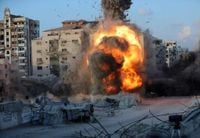Gaza City has been rocked by an unprecedented wave of destruction as Israeli forces intensified their campaign, leveling dozens of high-rise buildings and sending shockwaves through a population already battered by months of war. The escalation, which began in earnest over the weekend and reached a fever pitch on Monday, September 8, 2025, has left much of the city in ruins, displaced tens of thousands more Palestinians, and drawn condemnation from international observers and local residents alike.
According to multiple reports, including statements from the Israeli government and eyewitness accounts, the Israeli military destroyed at least 50 high-rise residential buildings in Gaza City over a two-day period. Prime Minister Benjamin Netanyahu, in a video address, confirmed the scale of the operation, declaring, “In the past two days, 50 of these towers have fallen. The air force brought them down. Now all of this is just an introduction, just a prelude, to the main intense operation—a ground maneuver of our forces, who are now organizing and gathering in Gaza City.” Netanyahu warned civilians to evacuate, stating, “This is just the prelude to the main powerful operation, so I tell Gaza residents: you have been warned, get out of there.”
The Israeli military has justified these strikes by asserting that Hamas has embedded surveillance infrastructure and command centers within civilian buildings. Defense Minister Israel Katz echoed this sentiment on social media, threatening that “a powerful hurricane will strike the skies of Gaza City, and the roofs of the terror towers will tremble.” Army spokesperson Avichay Adraee elaborated that any building converted into “terrorist infrastructure”—including those with cameras, sniper posts, and missile launch sites—would be targeted. The military released a video showing hundreds of buildings in Gaza City marked for bombing, underscoring the scale of the planned offensive.
Yet, for the more than one million residents of Gaza City—most of whom have already been displaced at least once—the bombardment has meant further chaos, suffering, and loss. Gaza’s Civil Defense spokesperson, Mahmoud Basal, accused Israel of pursuing a deliberate policy of forced displacement. “It is part of a policy of forcibly displacing civilians,” Basal said. “Entire families are being cast out into the streets, homeless and without shelter.” The high-rise towers, he noted, were among the few remaining buildings capable of housing thousands of displaced people. Their destruction, Basal argued, was intended to precipitate a mass exodus, leaving Gazans with nowhere to go.
The offensive has not been limited to airstrikes. Israeli forces have reportedly surrounded Gaza City from the north, south, and east, gradually pushing inward and effectively laying siege to the city. Eastern neighborhoods such as Zeitoun, al-Shuja’iyya, al-Tuffah, and Sabra have been almost completely destroyed, forcing residents to flee westward into already overcrowded displacement centers. The remaining western neighborhoods, including Sudaniyya, Shanti, al-Rimal, Shati, and Nabulsi, have become makeshift camps, with tents dotting the landscape and thousands crammed into temporary shelters.
Evacuation orders have been issued for several districts, including Abu Iskandar, Jabalia al-Nazla, al-Jalaa, and al-Nafaq Street, with residents given little time to gather their belongings. Faris Afana, Director of Emergency and Ambulance Services in Gaza City, described the situation as dire: “All areas in northern Gaza City have become extremely dangerous, and people are unable to walk in those areas.” Afana reported that the Israeli army has deployed quadcopter drones and cranes equipped with automatic guns to fire on civilians attempting to flee. “The Israeli army has also installed new cranes with automatic guns affixed to them, firing on people in the streets,” he said. Many families, unable to afford transportation or even basic tents—which now cost over a thousand dollars—have been forced to flee south on foot, leaving behind their homes and most of their possessions.
Personal stories of hardship and fear abound. Abdullah Abu Daf, a father of six, recounted fleeing the al-Maghrebi area after explosions rocked his neighborhood. “I hope the army is telling the truth and won’t bomb us after we leave our home,” he said. “We’ve seen death hundreds of times during this war, so we no longer fear it. When the army orders us to flee, we don’t flee for ourselves, the adults. We only want to protect our children. It’s not their fault that they should be burned to death or have their bodies eaten by dogs. That’s what happened with our neighbors and relatives in Gaza City.”
Hassan al-Hawi, another resident, described fleeing the Sheikh Radwan area after quadcopter drones began firing on homes. “We spent three days looking for a place to go, and in the end, we were forced to seek refuge in the UNRWA schools in Deir al-Balah,” he said. “The quadcopter would come near our homes and the voice over the loudspeaker would curse at us and threaten us, telling us to leave our homes. They would even fire at us from the windows and sometimes enter through them.” Al-Hawi summed up the prevailing sentiment: “Gaza has become a slaughterhouse for civilians. Israel is not bombing Hamas or targeting resistance fighters. It is targeting the defenseless, the besieged civilians who are denied food and water.”
Amid the devastation, the humanitarian crisis has deepened. Gaza’s Health Ministry reported that hospitals received the bodies of 65 people killed by Israeli fire in just 24 hours, with another 320 wounded. Since the start of the ground invasion in 2023, more than 450 Israeli soldiers have also been killed, according to the Israeli military, highlighting the ongoing intensity of the conflict.
Diplomatic efforts to halt the violence have so far faltered. On September 8, U.S. President Donald Trump issued what he called a “last warning” to Hamas, advancing a new ceasefire proposal that would see the immediate release of all remaining hostages in exchange for 3,000 Palestinian prisoners and a temporary ceasefire. The proposal, confirmed by Israeli Foreign Minister Gideon Saar as accepted by Israel, calls for a negotiated end to the war and the withdrawal of Israeli forces from Gaza once the hostages are released. However, a senior Hamas official dismissed the plan as a “humiliating surrender document,” objecting to provisions that require the release of all hostages on the first day, Hamas’s disarmament, and the establishment of a Gaza government acceptable to Israel. Nonetheless, Hamas said it would continue negotiations, seeking an agreement that “will end the war, halt the genocide, and open the horizon for a political solution that achieves our legitimate national goals, but not by signing a humiliating surrender document.”
The human toll of the conflict is staggering. Since October 2023, Israeli operations have killed more than 64,500 Palestinians, according to Gaza’s Health Ministry, with about half of the victims being women and children. Around 90% of Gaza’s two million residents have been displaced, and large swathes of major cities lie in ruins. The enclave faces famine, and the United Nations has repeatedly warned of impending humanitarian catastrophe.
The international legal ramifications are also mounting. In November 2024, the International Criminal Court issued arrest warrants for Netanyahu and former Defense Minister Yoav Gallant for war crimes and crimes against humanity in Gaza. Israel also faces a genocide case at the International Court of Justice, further complicating the already fraught geopolitical landscape.
As the world watches, Gaza’s future hangs in the balance. With both sides entrenched and the humanitarian situation worsening by the day, the prospect of peace remains elusive. For the people of Gaza City, survival has become a daily struggle amid the rubble of what was once their home.





